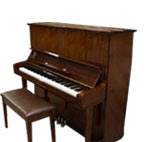When memorizing music there are several things you can do that will make your job that much easier. Memorizing music is important as most people know you play better when having the music in your head rather than having your head in the music. So where to start when memorizing music effectively?
I agree with Fred Noad, when discussing memorization in his book, Solo Guitar playing, he states…Learn to play a piece from beginning to end with absolutely correct fingering and with complete continuity (however slow) before committing it to memory.
To learn music in this fashion helps with an overall visual memory of the piece and it helps with continuity rather than have the piece sound disjointed and fragmented. If you think about it you will realize that our thoughts and memories are nothing more than powerful images or, pictures, if you like.
To prove my point let’s say I ask you to think of an elephant. What do you see? Is it the word elephant written down (which could be a picture) or is it a picture or part picture the animal itself? I bet you I know the answer. Another test would be to ask how you dreamed at night. Do you dream in words or are your dreams a series of pictures rather like a scene from a movie?
You need to work with your brain rather than against it. Why not utilize the natural operation of your memory? It’s crazy not to!
I also know from my days at Teacher’s College that most people have different strengths when it comes to learning something new based on the body’s different senses. Some people are visual learners, some learn better with their tactile (touching) sense and some are strong auditory learners.
What is clear in most literature about memory is that a combination of as many of your senses as possible is a stronger way of learning anything. Because of this we should employ most of our senses when learning a new piece of music. Of course we can’t include taste and smell to any great degree (unless you want to eat your music!) but we should definitely try to use our other senses of sight, hearing and touch.
So, having established a method of learning a new piece of music what comes next? What are the nuts and bolts, so to speak?
I would actually take a step back. That is, start not with playing a piece of music but rather just reading it, just like a book, on its own. What I would be looking for is how it is put together. I would look at the key, form, and structure of the music? What about sequences and repetitions? What about dynamics, articulation and tone?
Breaking a piece up into its component parts first before you start to play it and get a visual memory of the piece allows you to take a short-cut of sorts. If you understand where the repeats are, for example, you have already cut down on the amount of bars you have to memorize. If you know about the dynamics of the piece before you play it physically your brain won’t have to deal with too much information at once.
As Sharon Isbin says in the Classical Guitar Answer Book…”The more you understand the language and structure of a piece, the easier it will be to memorize.”
I liken it to driving to an unfamiliar place or suburb in your car and using a roadmap. If you just turn up and expect to find the street it would be very difficult indeed. But if you look at the map beforehand you stand a much better chance of finding your destination by noticing the signs along the way. You recognize where you are, with much less stress!
Of course, I’m talking about reading the music AWAY from the guitar. This should be your very first step. I would then employ the Noad method after this.
Next I would test my memory by playing the separate phrases in the music. If you definitely know a phrase, try to string it together with the next phrase in the piece and so on until you get to the end of the piece. If you are not confident to play phrases try playing one bar at a time and going back to the printed music when a bar is forgotten.
In this way the music can be overlapped until the whole piece can be played by memory.
I would leave the piece for several days to a week after that. Then I would test my memory again by trying to play the whole piece, making note of where I faltered or needed to consolidate. Leaving it for a period of time allows your subconscious brain to keep “working” on it for you. The subconscious is really quite powerful and when you get out of its way, you’ll be amazed at what it can achieve.
Studying a new piece in this fashion should yield results. And remember, the more you practice (properly) the easier it will become. Good luck!










